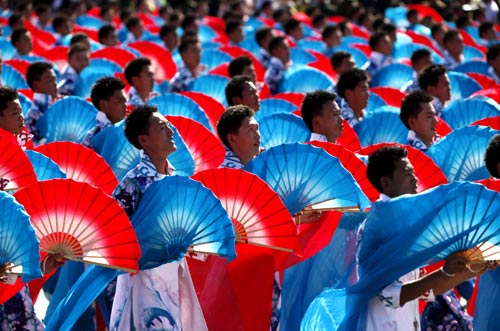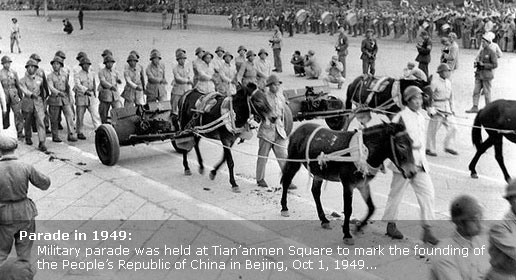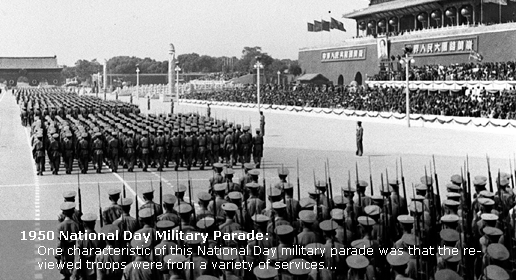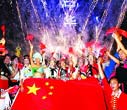News
Civilians celebrate six decades of achievements
By Xin Dingding (China Daily)
Updated: 2009-10-02 11:07
|
 Participants dance with fans during a massive parade to mark the 60th anniversary of the founding of the People's Republic of China in Beijing Thursday. [China Daily] |
Some 100,000 people, including foreigners, marched along 60 civilian floats on Tian'anmen Square, celebrating the 60th anniversary of New China on National Day Thursday.
About the parade and evening gala:Click to see the video
In 36 formations, they presented a review of China's growth and achievements.
The national flag, held and escorted by a symbolic 1,949 young men, was labeled the largest ever displayed in a National Day parade. It is nearly 600 sq m in size, bigger than a basketball court, and weighs 150 kg.
In succession, four giant portraits were carried through the square, escorted by 36,000 parade participants. The portraits were of late leader Chairman Mao Zedong; Deng Xiaoping, the chief architect of economic reform, former president Jiang Zemin and President Hu Jintao.
Recordings of the four leaders' voices made during significant moments in history were broadcast during the procession.
The portraits were accompanied by floats that featured the themes of the era of "self-reliance" for Mao, the era of "reform and opening up" for Deng, "three represents" for Jiang and "scientific outlook on development" for Hu.
The country's early leaders, especially Mao, are still well remembered by the public.
On the opposite of the square is a portrait of Sun Yat-sen, a forerunner of the Chinese democratic revolution.
Deng was renowned for masterminding the reform and opening-up drive, which saved China from an economic breakdown following the chaotic 10-year "cultural revolution" (1966-76) and ushered in an era of economic development.
Jiang proposed the important thought of "three represents", which required the Communist Party of China to always represent the development of China's socially productive forces, the progressive course of China's advanced culture and the fundamental interests of the overwhelming majority of the Chinese people.
While the portrait of Hu Jintao filed past the center of the square, a recording of his voice stated: "Work hard to achieve new victories in building a moderately prosperous society in all respects and write a new chapter of a happy life for the people."
The remark was delivered at the Communist Party of China (CPC) 17th National Congress on Oct 15, 2007, which endorsed the doctrine of a scientific outlook on development in the CPC's Constitution. The doctrine described the Party's determination to promote more coordinated development on the basis of social harmony, environmental protection and energy conservation, in addition to economic expansion.
China's achievements
Following the parade of portraits, 19 floats and 43,000 people from all walks of life celebrated China's achievements in agriculture, education, industry, sports, science and the space program.
The agriculture formation reflected China's success at improving grain production to feed today's population of 1.3 billion.
China has become the world's top producer of various farm products, with the country's grain output reaching 528 million tons and poultry production topping 72.8 million tons in 2008.
The industry formation reminded people of how a moribund industrial sector survived the disastrous "cultural revolution" to become a powerful production force that turned China into the world's workshop.
China, which 60 years ago had to import even boxes of matches, today is exporting goods ranging from lighters to satellites to more than 200 countries.
Another float carried models of China's domestically made jet, the ARJ21, as well as high-speed trains and automobiles.
Following was a formation featuring China's pursuit of clean energy through alternative resources such as nuclear and wind energy.
In fact, many of the parade's floats were energy-saving hybrid electric vehicles used for the first time at a National Day parade to promote China's determination to increase environmental protection.
The first Chinese astronaut to walk in space, Zhai Zhigang, waved a small national flag from the Shenzhou spaceship, but this time, not from space.
He and four other astronauts were on a float that also carried domestically made launch vehicles and satellites to illustrate China's ambitious space program.
Sports stars - including hurdler Liu Xiang, gymnast Li Ning and gold medalists of the 2008 Beijing Olympics - were part of two other formations showcasing China's achievements in sports.
'One world'
More than 100 foreigners appeared in the "One world" formation. One float with a sculpture of the planet Earth featured 26 foreign visitors from the United States, Australia, Cuba, Kenya and India.
Yesterday was the first time that foreigners actively participated in a National Day parade rather than just being part of the audience.
Some 100 foreign parade participants wearing "I love China" T-shirts walked beside the float, speaking Mandarin to offer good wishes to parade-watchers.
Following the 19 parade formations showcasing advancements came 34 more floats representing the unique attributes of China's 31 mainland regions, Hong Kong, Macao and Taiwan. These floats were accompanied by 8,500 people.
The Taiwan float, carrying two miniature airplanes flying from each side of a rainbow to signal the start of direct air and sea transportation service last year, highlighted the improved cross-Straits relations between the Chinese mainland and the island province.
During the final part of the civilian pageant, thousands of children and a simulated boat passed the Tian'anmen rostrum, conveying the message that children are the future of the country.
With 60,000 doves of peace and colorful balloons released into the sky, the children surged toward the Golden Water Bridge at the north of Tian'anmen Square.
The civilian pageant lasted more than one and a half hours, following three months of training.
"Although each float shows the achievement in one field, the entire mass pageant impressed me with China's strong deployment ability and its unity," said Dong Jiayao, a TV anchor with Hong Kong-based Phoenix TV.
All through the military and civilian parade, 80,000 students flipped huge placards to make slogans and patterns on Tian'anmen Square.
A 1,500-member military brass band, a 2,100-member adult choir, a 300-member children's choir and a 130-member folk percussion group also sang and played 21 songs accompanying the civilian pageant.













